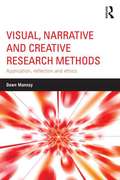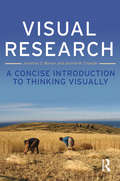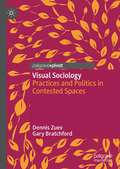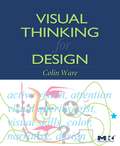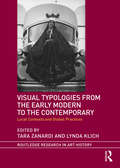- Table View
- List View
Visual Methods with Children and Young People: Academics and Visual Industries in Dialogue (Studies in Childhood and Youth)
by Eve Stirling Dylan Yamada-RiceThis volume focuses on using visual research methods with children and young people. Featuring insights from academic experts and established professionals from visual industries, it explores a range of issues from visual ethics to children's interaction with place.
Visual, Narrative and Creative Research Methods: Application, reflection and ethics
by Dawn MannayVisual research methods are quickly becoming key topics of interest and are now widely recognised as having the potential to evoke emphatic understanding of the ways in which other people experience their worlds. Visual, Narrative and Creative Research Methodsexamines the practices and value of these visual approaches as a qualitative tool in the field of social science and related disciplines. This book is concerned with the process of applying visual methods as a tool of inquiry from design, to production, to analysis and dissemination. Drawing on research projects which reflect real world situations, you will be methodically guided through the research process in detail, enabling you to examine and understand the practices and value of visual, narrative and creative approaches as effective qualitative tools. Key topics include: techniques of data production, including collage, mapping, drawing and photographs; the practicalities of application; the positioning of the researcher; interpretation of visual data; images and narratives in public spaces; evaluative analysis of creative approaches. Visual, Narrative and Creative Research Methodswill be an invaluable companion for researchers, postgraduate students and other academics with an interest in visual and creative methods and qualitative research.
Visual Political Communication
by Daniel Jackson Darren G. Lilleker Anastasia VenetiThis edited volume offers a theoretically driven, empirically grounded survey of the role visual communication plays in political culture, enabling a better understanding of the significance and impact visuals can have as tools of political communication. The advent of new media technologies have created new ways of producing, disseminating and consuming visual communication, the book hence explores the theoretical and methodological underpinnings of visual political communication in the digital age, and how visual communication is employed in a number of key settings. The book is intended as a specialist reading and teaching resource for courses on media, politics, citizenship, activism, social movements, public policy, and communication.
Visual Research: A Concise Introduction to Thinking Visually
by Jerome W. Crowder Jonathan S. MarionVisual Research: A Concise Introduction to Thinking Visually 2nd Edition provides an accessible introduction to doing visual research in the social sciences. Beginning with ethical considerations, this book highlights the importance of thinking visually before engaging in visual research. Further themes involve creating, organizing, and using images and are presented so as to help readers think about and work with their own visual data. This fully updated second edition includes new case studies, updated discussions regarding the ethics of social media and online content, new technology and an expansion to include new material on museum, public and applied work. Concise and highly focused, Visual Research is an invaluable resource for visual, media, and communications students and researchers and others interested in visual research in the social sciences.
Visual Research: A Concise Introduction to Thinking Visually
by Jerome W. Crowder Jonathan S. MarionVisual Research: A Concise Introduction to Thinking Visually 2nd Edition provides an accessible introduction to doing visual research in the social sciences. Beginning with ethical considerations, this book highlights the importance of thinking visually before engaging in visual research. Further themes involve creating, organizing, and using images and are presented so as to help readers think about and work with their own visual data. This fully updated second edition includes new case studies, updated discussions regarding the ethics of social media and online content, new technology and an expansion to include new material on museum, public and applied work. Concise and highly focused, Visual Research is an invaluable resource for visual, media, and communications students and researchers and others interested in visual research in the social sciences.
Visual Research: A Concise Introduction to Thinking Visually
by Jonathan S. Marion Jerome W. CrowderVisual Research: A Concise Introduction to Thinking Visually is the first text to present a concise overview of the significant ethical, theoretical, and practical considerations for conducting research with images. The capacity to take photos and video on handheld devices and the ability to store, post, and share such imagery online all offer tremendous opportunities for social research. The rapid development and popularity of such technology means that little technological proficiency is required, and even less theoretical and ethical consideration. This book provides an accessible introduction to doing visual research in the social sciences. Beginning with ethical considerations, this book highlights the importance of thinking visually before engaging in visual research. Further themes involve creating, organizing, and using images and are presented so as to help readers think about and work with their own visual data. Boxed case studies and further reading suggestions enhance the utility of this primer. Concise and highly focused, Visual Research will be an invaluable resource for visual, media, and communications students and researchers and others interested in visual research in the social sciences.
Visual Research: A Concise Introduction to Thinking Visually
by Jonathan S. Marion Jerome W. CrowderVisual Research: A Concise Introduction to Thinking Visually is the first text to present a concise overview of the significant ethical, theoretical, and practical considerations for conducting research with images. The capacity to take photos and video on handheld devices and the ability to store, post, and share such imagery online all offer tremendous opportunities for social research. The rapid development and popularity of such technology means that little technological proficiency is required, and even less theoretical and ethical consideration. This book provides an accessible introduction to doing visual research in the social sciences. Beginning with ethical considerations, this book highlights the importance of thinking visually before engaging in visual research. Further themes involve creating, organizing, and using images and are presented so as to help readers think about and work with their own visual data. Boxed case studies and further reading suggestions enhance the utility of this primer. Concise and highly focused, Visual Research will be an invaluable resource for visual, media, and communications students and researchers and others interested in visual research in the social sciences.
Visual Research Methods in Educational Research
by Barbara Pini Julianne MossHave you noticed there is a burgeoning take up of visual research in education? Are you considering using visual research as part of your next research project or revitalising your research methods course? For researchers who are new to the field of VRMs in education there is little critical literature on the subject. This book addresses the gap in the literature and brings together some of the leading educational researchers engaging and reflecting on the visual from Australia, the UK and Canada. Encapsulated in a single volume, this book sets out theoretically grounded discussions of the possibilities and challenges of the approach for educational researchers around four key themes: images of schooling, performing pedagogy, power and representation and ethical issues in educational research.
Visual Research Methods in the Social Sciences: Awakening Visions (PDF)
by Stephen SpencerVisual Research Methods is a guide for students, researchers and teachers in the social sciences who wish to explore and actively use a visual dimension in their research. This book offers an integrated approach to doing visual research, showing the potential for building convincing case studies using a mix of visual forms including: archive images, media, maps, objects, buildings, and video interviews. Examples of the visual construction of ‘place’, social identity and trends of analysis are given in the first section of the book, whilst the essays in the second section highlight the astonishing creativity and innovation of four visual researchers. Each detailed example serves as a touchstone of quality and analysis in research, with themes ranging from the ethnography of a Venezuelan cult goddess to the forensic photography of the skeleton of a fourteenth-century nobleman. They give a keen sense of the motives, philosophies and benefits of using visual research methods. This volume will be of practical interest to those embarking on visual research as well as more experienced researchers. Key concerns include the power of images and their changing significance in a world of cross – mediation, techniques of analysis and ethical issues, and how to unlock the potential of visual data for research.
Visual Research Methods in the Social Sciences: Awakening Visions
by Stephen SpencerVisual Research Methods in the Social Sciences: Awakening Visions is an indispensable resource for students, researchers and teachers seeking to use visual sources in their research and understand how images work. This fully updated edition adds questions and activities for studies and many new images and models as well as additional exploration of social and theoretical contexts and examples of current visual and multimodal research.Due to the proliferation of image-centric social media and the growing potential for ‘fake news’, being able to critically assess media and other visual messages is more important than ever. For researchers embarking on visual research this book offers useful practical guidance and real-world examples from seasoned researchers exploring cultures as varied as: religious cults in Venezuela, the Beer Can Regatta in Darwin, Mapuche Indians in Chile and graffiti artists in Sheffield. It offers an integrated approach to visual research, building compelling case studies using a wide range of visual forms, including: archive images, media samples, maps, objects, video, photographs and drawings alongside traditional qualitative approaches. Examples of the visual construction of ‘place’, representations of social identities and different approaches to analysis are explored in the first section of the book, whilst the essays in the second section highlight the creativity and innovation of four leading visual researchers. This new edition will prove valuable for both experienced visual researchers and those embarking on visual research in the social sciences for the first time.
Visual Research Methods in the Social Sciences: Awakening Visions
by Stephen SpencerVisual Research Methods in the Social Sciences: Awakening Visions is an indispensable resource for students, researchers and teachers seeking to use visual sources in their research and understand how images work. This fully updated edition adds questions and activities for studies and many new images and models as well as additional exploration of social and theoretical contexts and examples of current visual and multimodal research.Due to the proliferation of image-centric social media and the growing potential for ‘fake news’, being able to critically assess media and other visual messages is more important than ever. For researchers embarking on visual research this book offers useful practical guidance and real-world examples from seasoned researchers exploring cultures as varied as: religious cults in Venezuela, the Beer Can Regatta in Darwin, Mapuche Indians in Chile and graffiti artists in Sheffield. It offers an integrated approach to visual research, building compelling case studies using a wide range of visual forms, including: archive images, media samples, maps, objects, video, photographs and drawings alongside traditional qualitative approaches. Examples of the visual construction of ‘place’, representations of social identities and different approaches to analysis are explored in the first section of the book, whilst the essays in the second section highlight the creativity and innovation of four leading visual researchers. This new edition will prove valuable for both experienced visual researchers and those embarking on visual research in the social sciences for the first time.
Visual Sociology
by Douglas HarperVisual sociology has been part of the sociological vocabulary since the 1970s, but until now there has not been a comprehensive text that introduces this area. Written by one of the founding fathers in the field, Visual Sociology explores how the world that is seen, photographed, drawn, or otherwise represented visually is different from the world that is represented through words and numbers. Doug Harper’s exceptional photography and engaging, lively writing style will introduce: visual sociology as embodied observation visual sociology as semiotics visual sociology as an approach to data: empirical, narrative, phenomenological and reflexive visual sociology as an aspect of photo documentary visual sociology and multimedia. This definitive textbook is made up of eleven chapters on the key topics in visual sociology. With teaching and learning guidance, as well as clear, accessible explanations of current thinking in the field, this book will be an invaluable resource to all those with an interest in visual sociology, research methods, cultural geography, cultural theory or visual anthropology.
Visual Sociology
by Douglas HarperVisual sociology has been part of the sociological vocabulary since the 1970s, but until now there has not been a comprehensive text that introduces this area. Written by one of the founding fathers in the field, Visual Sociology explores how the world that is seen, photographed, drawn, or otherwise represented visually is different from the world that is represented through words and numbers. Doug Harper’s exceptional photography and engaging, lively writing style will introduce: visual sociology as embodied observation visual sociology as semiotics visual sociology as an approach to data: empirical, narrative, phenomenological and reflexive visual sociology as an aspect of photo documentary visual sociology and multimedia. This definitive textbook is made up of eleven chapters on the key topics in visual sociology. With teaching and learning guidance, as well as clear, accessible explanations of current thinking in the field, this book will be an invaluable resource to all those with an interest in visual sociology, research methods, cultural geography, cultural theory or visual anthropology.
Visual Sociology
by Douglas HarperThis new version of the authoritative textbook in the field of visual sociology focuses on the key topics of documentary photography, visual ethnography, collaborative visual research, visual empiricism, the study of the visual symbol and teaching sociology visually. This updated and expanded edition includes nearly twice as many images and incorporates new in-depth case studies, drawing upon the author’s lifetime of pioneering research and teaching as well as the often neglected experiences of women and people of color. The book examines how documentary photography can be useful to sociologists, both because of the topics examined by documentarians and as an example of how seeing is socially constructed. Harper describes the exclusion of women through much of the history of documentary photography and the distinctiveness of the female eye in recent documentary, a phenomenon he calls "the gendered lens". The author examines how a visual approach allows sociologists to study conventional topics differently, while offering new perspectives, topics and insights. For example, photography shows us how perspective itself affects what we see and know, how abstractions such as "ideal types" can be represented visually, how social change can be studied visually and how the study of symbols can lead us to interpret public art, architecture and person-made landscapes. There is an extended study of how images can lead to cooperative research and learning; how images can serve as bridges of understanding, blurring the lines between researcher and researched. The important topic of reflexivity is examined by close study of Harper’s own research experiences. Finally, the author focusses on teaching, offering templates for full courses, assignments and projects, and guides for teachers imagining how to approach visual sociology as a new practice. This definitive yet accessible textbook will be indispensable to teachers, researchers and professionals with an interest in visual sociology, research methods, cultural theory and visual anthropology.
Visual Sociology
by Douglas HarperThis new version of the authoritative textbook in the field of visual sociology focuses on the key topics of documentary photography, visual ethnography, collaborative visual research, visual empiricism, the study of the visual symbol and teaching sociology visually. This updated and expanded edition includes nearly twice as many images and incorporates new in-depth case studies, drawing upon the author’s lifetime of pioneering research and teaching as well as the often neglected experiences of women and people of color. The book examines how documentary photography can be useful to sociologists, both because of the topics examined by documentarians and as an example of how seeing is socially constructed. Harper describes the exclusion of women through much of the history of documentary photography and the distinctiveness of the female eye in recent documentary, a phenomenon he calls "the gendered lens". The author examines how a visual approach allows sociologists to study conventional topics differently, while offering new perspectives, topics and insights. For example, photography shows us how perspective itself affects what we see and know, how abstractions such as "ideal types" can be represented visually, how social change can be studied visually and how the study of symbols can lead us to interpret public art, architecture and person-made landscapes. There is an extended study of how images can lead to cooperative research and learning; how images can serve as bridges of understanding, blurring the lines between researcher and researched. The important topic of reflexivity is examined by close study of Harper’s own research experiences. Finally, the author focusses on teaching, offering templates for full courses, assignments and projects, and guides for teachers imagining how to approach visual sociology as a new practice. This definitive yet accessible textbook will be indispensable to teachers, researchers and professionals with an interest in visual sociology, research methods, cultural theory and visual anthropology.
Visual Sociology: Practices and Politics in Contested Spaces (Routledge Advances In Sociology Ser. #91)
by Dennis Zuev Gary BratchfordThis book provides a user-friendly guide to the expanding scope of visual sociology, through a discussion of a broad range of visual material, and reflections on how such material can be studied sociologically. The chapters draw on specific case-study examples that examine the complexity of the hyper-visual social world we live in, exploring three domains of the ‘relational image’: the urban, social media, and the aerial. Zuev and Bratchford tackle issues such as visual politics and surveillance, practices of visual production and visibility, analysing the changing nature of the visual. They review a range of methods which can be used by researchers in the social sciences, utilising new media and their visual interfaces, while also assessing the changing nature of visuality. This concise overview will be of use to students and researchers aiming to adopt visual methods and theories in their own subject areas such as sociology, visual culture and related courses in photography, new-media and visual studies.
Visual Thinking for Design
by Colin WareVisual Thinking brings the science of perception to the art of design. Designers increasingly need to present information in ways that aid their audience’s thinking process. Fortunately, results from the relatively new science of human visual perception provide valuable guidance. In this book, Colin Ware takes what we now know about perception, cognition, and attention and transforms it into concrete advice that designers can directly apply. He demonstrates how designs can be considered as tools for cognition – extensions of the viewer’s brain in much the same way that a hammer is an extension of the user’s hand. The book includes hundreds of examples, many in the form of integrated text and full-color diagrams. Experienced professional designers and students alike will learn how to maximize the power of the information tools they design for the people who use them.Presents visual thinking as a complex process that can be supported in every stage using specific design techniquesProvides practical, task-oriented information for designers and software developers charged with design responsibilitiesIncludes hundreds of examples, many in the form of integrated text and full-color diagramsSteeped in the principles of “active vision," which views graphic designs as cognitive tools
Visual Typologies from the Early Modern to the Contemporary: Local Contexts and Global Practices (Routledge Research in Art History)
by Tara Zanardi and Lynda KlichVisual Typologies from the Early Modern to the Contemporary investigates the pictorial representation of types from the sixteenth to the twenty- first century. Originating in longstanding visual traditions, including street crier prints and costume albums, these images share certain conventions as they seek to convey knowledge about different peoples. The genre of the type became widespread in the early modern period, developing into a global language of identity. The chapters explore diverse pictorial representations of types, customs, and dress in numerous media, including paintings, prints, postcards, photographs, and garments. Together, they reveal that the activation of typological strategies, including seriality, repetition, appropriation, and subversion has produced a universal and dynamic pictorial language. Typological images highlight the tensions between the local and the international, the specific and the communal, and similarity and difference inherent in the construction of identity. The first full- length study to treat these images as a broader genre, Visual Typologies gives voice to a marginalized form of representation. Together, the chapters debunk the classification of such images as unmediated and authentic representations, offering fresh methodological frameworks to consider their meanings locally and globally, and establishing common ground about the operations of objects that sought to shape, embody, or challenge individual and collective identities.
Visual Typologies from the Early Modern to the Contemporary: Local Contexts and Global Practices (Routledge Research in Art History)
by Tara Zanardi Lynda KlichVisual Typologies from the Early Modern to the Contemporary investigates the pictorial representation of types from the sixteenth to the twenty- first century. Originating in longstanding visual traditions, including street crier prints and costume albums, these images share certain conventions as they seek to convey knowledge about different peoples. The genre of the type became widespread in the early modern period, developing into a global language of identity. The chapters explore diverse pictorial representations of types, customs, and dress in numerous media, including paintings, prints, postcards, photographs, and garments. Together, they reveal that the activation of typological strategies, including seriality, repetition, appropriation, and subversion has produced a universal and dynamic pictorial language. Typological images highlight the tensions between the local and the international, the specific and the communal, and similarity and difference inherent in the construction of identity. The first full- length study to treat these images as a broader genre, Visual Typologies gives voice to a marginalized form of representation. Together, the chapters debunk the classification of such images as unmediated and authentic representations, offering fresh methodological frameworks to consider their meanings locally and globally, and establishing common ground about the operations of objects that sought to shape, embody, or challenge individual and collective identities.
Visual Typologies from the Early Modern to the Contemporary: Local Contexts and Global Practices (Routledge Research in Art History)
by Tara Zanardi Lynda KlichVisual Typologies from the Early Modern to the Contemporary investigates the pictorial representation of types from the sixteenth to the twenty- first century. Originating in longstanding visual traditions, including street crier prints and costume albums, these images share certain conventions as they seek to convey knowledge about different peoples. The genre of the type became widespread in the early modern period, developing into a global language of identity. The chapters explore diverse pictorial representations of types, customs, and dress in numerous media, including paintings, prints, postcards, photographs, and garments. Together, they reveal that the activation of typological strategies, including seriality, repetition, appropriation, and subversion has produced a universal and dynamic pictorial language. Typological images highlight the tensions between the local and the international, the specific and the communal, and similarity and difference inherent in the construction of identity. The first full- length study to treat these images as a broader genre, Visual Typologies gives voice to a marginalized form of representation. Together, the chapters debunk the classification of such images as unmediated and authentic representations, offering fresh methodological frameworks to consider their meanings locally and globally, and establishing common ground about the operations of objects that sought to shape, embody, or challenge individual and collective identities.
Visual Usability: Principles and Practices for Designing Digital Applications
by Tania Schlatter Deborah LevinsonImagine how much easier creating web and mobile applications would be if you had a practical and concise, hands-on guide to visual design. Visual Usability gets into the nitty-gritty of applying visual design principles to complex application design. You’ll learn how to avoid common mistakes, make informed decisions about application design, and elevate the ordinary. We’ll review three key principles that affect application design – consistency, hierarchy, and personality – and illustrate how to apply tools like typography, color, and layout to digital application design. Whether you’re a UI professional looking to fine-tune your skills, a developer who cares about making applications beautiful and usable, or someone entirely new to the design arena, Visual Usability is your one-stop, practical guide to visual design.Discover the principles and rules that underlie successful application design Learn how to develop a rationale to support design strategy and move teams forwardMaster the visual design toolkit to increase user-friendliness and make complicated processes feel straightforward for your product
The Visualised Foetus: A Cultural and Political Analysis of Ultrasound Imagery
by Julie RobertsThe latest three- and four dimensional images produced by modern ultrasound technology offer strikingly realistic representations of the foetus - representations that have further transformed experiences of pregnancy, the public understanding of foetal existence and the rhetoric of the abortion debate. Presenting a timely feminist engagement with this new technology, The Visualised Foetus explores the widespread familiarity with and popularity of this new technology within the context of a longer history of foetal visualisations. The book offers an array of case studies that examine the diffusion of 3/4D ultrasound images beyond the clinic and the implications of this new technology for biopolitics in the European and American context. With attention to the non-diagnostic and commercial use of 3/4D images, the impact of 3/4D ultrasound within the abortion debate, and new claims that ultrasound aids maternal-foetal bonding, The Visualised Foetus demonstrates the tension between the social and medical significances of foetal ultrasound, the pleasures and dangers of foetal imagery for women, the contested status of ultrasonography as 'scientific' imagery, and struggles over the authority to define and interpret ultrasound imagery. As such, it will appeal to scholars of the sociology of medicine and the body, social theory and gender and cultural studies, as well as those with interest in science and technology studies.
The Visualised Foetus: A Cultural and Political Analysis of Ultrasound Imagery
by Julie RobertsThe latest three- and four dimensional images produced by modern ultrasound technology offer strikingly realistic representations of the foetus - representations that have further transformed experiences of pregnancy, the public understanding of foetal existence and the rhetoric of the abortion debate. Presenting a timely feminist engagement with this new technology, The Visualised Foetus explores the widespread familiarity with and popularity of this new technology within the context of a longer history of foetal visualisations. The book offers an array of case studies that examine the diffusion of 3/4D ultrasound images beyond the clinic and the implications of this new technology for biopolitics in the European and American context. With attention to the non-diagnostic and commercial use of 3/4D images, the impact of 3/4D ultrasound within the abortion debate, and new claims that ultrasound aids maternal-foetal bonding, The Visualised Foetus demonstrates the tension between the social and medical significances of foetal ultrasound, the pleasures and dangers of foetal imagery for women, the contested status of ultrasonography as 'scientific' imagery, and struggles over the authority to define and interpret ultrasound imagery. As such, it will appeal to scholars of the sociology of medicine and the body, social theory and gender and cultural studies, as well as those with interest in science and technology studies.
Visualisierung und Interaktion: Interaktionssoziologische Perspektiven auf die Methode der visualisierten Diskussionsführung (essentials)
by Mascha NolteInteraktionen in Organisationen – wie Meetings oder Workshops – bergen ein hohes Frustrationspotenzial: Man redet aneinander vorbei, wiederholt sich ständig und häufig kommt es zu einer Verlagerung von der Sach- auf die Sozialdimension, was konstruktive Diskussionen erschwert. Anhand einer bereits ab den 1960er Jahren entwickelten Moderationsmethode wird gezeigt, wie die Visualisierung von Diskussionen auf diese typischen Fallstricke von Interaktionen reagiert und ein höheres Maß der Komplexitätsverarbeitung ermöglicht. Theoretisch greift der Beitrag dabei auf zentrale Überlegungen aus der Interaktionssoziologie zurück
Visualisierung von Textprozessen: Die kommunikative Organisation von Informationen durch Bilder
by Graziella Tonfoni Annely RothkegelEin konsistentes visuelles Repräsentationssystem knüpft an Erfahrungen und Bildwelten in anderen Lebens- und Wissenschaftsbereichen an und verdeutlicht durch visuelle Metaphern (geometrische Figuren, Textmaschinen), die die Prozesse des Textverstehens und Textproduzierens nachvollziehbar machen, wie Information und Kommunikation im Text zusammenkommen. Die Autorinnen zeigen, dass die metaphorische Sprache insgesamt ein konzeptuelles Instrument für Theorie und Praxis der Arbeit an Dokumenten bildet und dass sich das vorgestellte System sowohl für den Umgang mit Geschichten als auch zur Organisation der E-Mail-Kommunikation einsetzen lässt.

